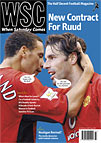 The First Division may be renamed The Football League Championship
The First Division may be renamed The Football League Championship
Three years ago, we suggested that if a marketing company were ever presented with the task of revamping football they might suggest renaming it Krazy Kick, or Leggy Fun. In fact, 13 years ago we speculated that soon we would be reading about “the Hyper League or the Supreme Set-up or the Utter Division”. We’re horrified to discover that the Football League are entertaining similar thoughts, only they appear to be serious.
It has recently been revealed that the First Division may be renamed “The Football League Championship” from next season, with the lower levels renamed, astonishingly, the First and Second Division. This brilliant scheme is one of a series of proposals developed by an agency called TBWA, previously responsible for the “acclaimed” (it says here) Wonderbra and FCUK campaigns. Club chairmen are to discuss the agency’s ideas in April and will put them to a vote in June.
Reports of the planned “re-branding” suggest that it has the support of those who lobbied for the removal of the previous League chairman, David Burns, over the ITV Digital fiasco. Take a bow, Millwall chairman Theo Paphitis and the bumptious Simon Jordan of Crystal Palace (the man who wouldn’t even contemplate taking part in the play-offs this season – only automatic promotion was good enough). One has to have some sympathy for the League’s staff – it can’t be easy having people like these constantly breathing down your necks, though the promotion of Birmingham in 2002 did at least provide some respite from the incessant scheming of Karren Brady and the porn barons.
The problem is, those who agitate for changes to the First Division don’t actually want to be members of it; they want to be in the Premier League. And if they can’t achieve that, they want to kid themselves they have the next best thing, Premier League II (a concept last floated two years ago when various chairmen, led by the subsequently disgraced Geoffrey Richmond of Bradford City, tried to invite Rangers and Celtic to join them) or at the very least a competition that sounds a bit more like the Premiership. It’s as if the Football League was some generic brand of gin hoping to fool the absent-minded punter by sticking itself in a green bottle and calling itself “Gordans”.
But why does the product need re-branding at all? Half a million people watched Nationwide games on the last weekend in January – more than went to the theatre. It already has a big audience. These people shouldn’t be patronised, nor will they be conned into thinking that what they pay to see each week has been magically transformed by a change of wording and a swish new logo.
The whole idea of “Premier II” is based on a false premise: that the success of the Premiership was based on the name rather than the relentless promotion by Sky and the Murdoch press, catching a wave of popularity after Italia 90, combined with the money that was coming into the game from a variety of sources improving the quality at the top end and the facilities pretty much everywhere. Crass marketing scams – giant inflat-able wrestlers, bands at half-time – got precisely nowhere and the ill-judged fireworks at Wolves v Newcastle have surely put an end to such needless sideshows.
In the absence of a major rival to the world’s most famous Australian-American tycoon, it’s hard to imagine anyone is going to do the same for Division One no matter what they call it – in fact the ITV Digital debacle was precisely a failed attempt to pull this trick off. If name changes really matter why don’t the club chairmen go the way of their rugby league counterparts – Cardiff Crusaders, Selhurst Park Patriots etc? But we don’t want to put more ideas in their heads.
No, we would rather remind them what a phenomenally successful product they have. In 1991-92, the turnstiles racked up 5.8 million people watching the 24 teams in what was then Division Two. Last season, you could reverse those figures: 8.5m watched Division One games. The third tier is up from a fraction under 3m to 3.9m, while the bottom rung – though effectively only 22 teams back in 1992 – is up close to 50 per cent, from 1.7m to nearly 2.5m.
League football, whatever you call it, is incredibly popular. In the hands of responsible businessmen these would be recognised as boom years – not the time to make pointless ego-boosting changes that can only devalue the product.
From WSC 205 March 2004. What was happening this month